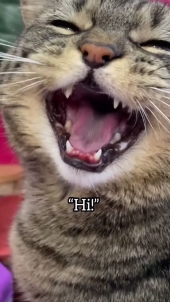
 6
6





Invasive plants are Earth's way of insisting we notice her medicines. Stephen Herrod Buhner
Everyone learns what works by learning what doesn't work. Stephen Herrod Buhner
 6
6




![Filename: SGK_1174.jpg
Description: [Thumbnail for SGK_1174.jpg]](/t/193396/a/191492/SGK_1174.jpg)
 6
6




Denise Kersting wrote:Here's our dilute calico, she's a spicy kitty in gray, lilac, creams, and white.
Invasive plants are Earth's way of insisting we notice her medicines. Stephen Herrod Buhner
Everyone learns what works by learning what doesn't work. Stephen Herrod Buhner
 4
4




"The only thing...more expensive than education is ignorance."~Ben Franklin. "We can easily forgive a child who is afraid of the dark; the real tragedy of life is when men are afraid of the light." ~ Plato
 5
5




Carla said, "but tend to prefer calico with generous bits of white - my favorite kitty color combo....
Invasive plants are Earth's way of insisting we notice her medicines. Stephen Herrod Buhner
Everyone learns what works by learning what doesn't work. Stephen Herrod Buhner
 3
3




"The only thing...more expensive than education is ignorance."~Ben Franklin. "We can easily forgive a child who is afraid of the dark; the real tragedy of life is when men are afraid of the light." ~ Plato
 10
10




Anne Miller wrote:
Thought I should expand on that, lol. Her name is Gabby Mayhem, because when she isn't talking (exceptionally loud for her size) she is creating mayhem. When she is sweet, she is super-lovey sweet . . . and when she is not, she can be an absolute terror. She loves eating mice, playing with snakes, and absolutely ruling her domain. But back to the original question, I love the silver/smoke-colored kitties like this:Denise Kersting wrote:spicy kitty
 5
5




![Filename: turkishvan.png
Description: [Thumbnail for turkishvan.png]](/t/193396/a/191586/turkishvan.png)
"The world is changed by your example, not your opinion." ~ Paulo Coelho
 6
6




Invasive plants are Earth's way of insisting we notice her medicines. Stephen Herrod Buhner
Everyone learns what works by learning what doesn't work. Stephen Herrod Buhner
 9
9




 7
7




Invasive plants are Earth's way of insisting we notice her medicines. Stephen Herrod Buhner
Everyone learns what works by learning what doesn't work. Stephen Herrod Buhner
 6
6




"The world is changed by your example, not your opinion." ~ Paulo Coelho
 7
7





|
All praise hypno-ad
Rocket Mass Heater Resources Wiki
https://permies.com/w/rmh-resources
|





